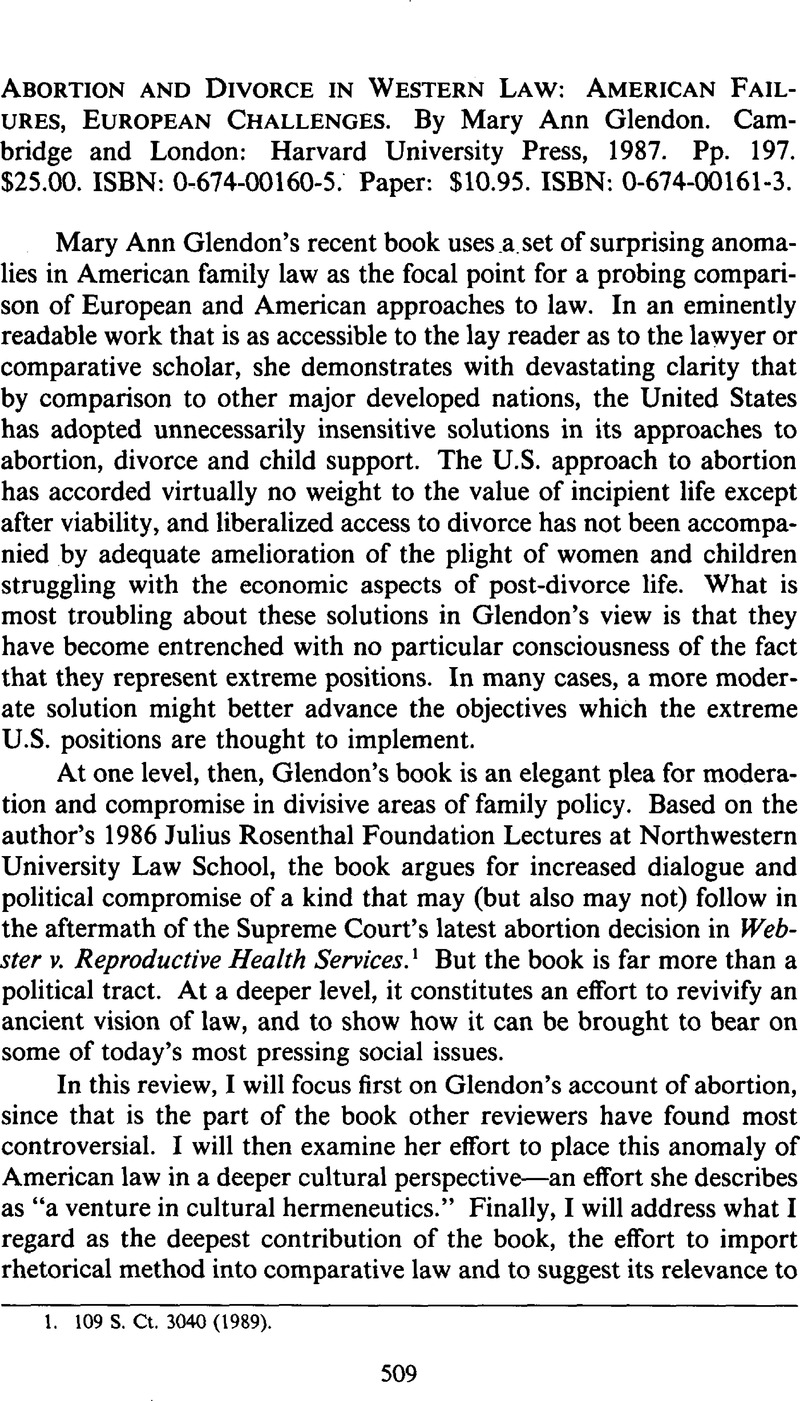No CrossRef data available.
Article contents
Abortion and Divorce in Western Law: American Failures, European Challenges. By Mary Ann Glendon. Cambridge and London: Harvard University Press, 1987. Pp. 197. $25.00. ISBN: 0-674-00160-5. Paper: $10.95. ISBN: 0-674-00161-3.
Published online by Cambridge University Press: 24 April 2015
Abstract

- Type
- Book Reviews
- Information
- Copyright
- Copyright © Center for the Study of Law and Religion at Emory University 1988
References
1. 109 S. Ct. 3040 (1989).
2. See id. at 3054-55 (plurality opinion). Justice O'Connor concurs with the plurality on this point, adding that the viability-testing provision under scrutiny makes sense only if the examinations and tests “would not be imprudent or careless to perform in the particular medical situation before the physician.” Id. at 3060. Justice Scalia concurred in the result, though he would have preferred to accentuate the tension between the viability-testing provision and Roe v. Wade in order to precipitate an overruling of that case.
3. 410 U.S. 113 (1973).
4. Judgment of Feb. 25, 1975, 39 BV erfGE 1. English translations: The Abortion Decision of February 25, 1975, of the Federal Constitutional Court, Federal Republic of Germany (Jann, Edmund C. trans. 1975)Google Scholar; Jonas, & Gorby, (trans.), West German Abortion Decision: A Contrast to Roe v. Wade, 9 John Marshall Journal of Practice and Procedure 605 (1976)Google ScholarPubMed.
5. See, e.g., White, J., Heracles' Bow: Essays on the Rhetoric and Poetics of Law (1985)Google Scholar; White, , Law as Rhetoric, Rhetoric as Law: The Arts of Cultural and Communal Life, 52 U. Chi. L. Rev. 684 (1985)CrossRefGoogle Scholar.
6. See, e.g., Geertz, C., Local Knowledge: Further Essays In Interpretive Anthropology (1983)Google Scholar.
7. The classic short study of this tradition in its bearing on law is Viehweg, T., Topik und Jurisprudenz: Ein Beitrag Zur Rechtswissenschaftlichen Grundlagenforschung (5th ed. 1974)Google Scholar. For an excellent recent summation of the tradition, see Vickers, B., In Defence of Rhetoric (1988)Google Scholar. Also see Kennedy, G., The Art of Persuasion in Greece (1963)Google Scholar [hereinafter cited as Kennedy, Greek Rhetoric]; Kennedy, G., The Art of Rhetoric in the Roman World (1972)Google Scholar [hereinafter cited as Kennedy, Roman Rhetoric]; Kennedy, G., Classical Rhetoric and its Christian and Secular Tradition from Ancient to Modern Times (1980)Google Scholar [hereinafter cited as Kennedy, Ancient to Modern Rhetoric]; Murphy, J., Rhetoric in the Middle Ages: A History of Rhetorical Theory from Saint Augustine to the Renaissance (1974)Google Scholar.
8. See generally T. Viehweg, supra note 7, at 15-18, 29-30; G. Kennedy, Ancient to Modern Rhetoric, supra note 7; J. Murphy, supra note 7.
9. See, e.g., Abelson, P., The Seven Liberal Arts: A Study in Mediaeval Culture (1965)Google Scholar; Baldwin, T., William Shakspere's Small Latine and Lesse Greeke (1944)Google Scholar; Marrou, H., A History of Education in Antiquity (Lamb, G. trans. 1956)Google Scholar; T. Viehweg, supra note 7, at 30; B. Vickers, supra note 7, at 11-12. Rhetorical training was particularly vital for lawyers. See Schoeck, , Lawyers and Rhetoric in Sixteenth-Century England, in Murphy, J. (Ed.), Renaissance Eloquence: Studies in the Theory and Practice of Renaissance Rhetoric (1983)Google Scholar.
10. See, e.g., Kennedy, Ancient to Modern Rhetoric, supra note 7; B. Vickers, supra note 7, at 439-457.
11. One thinks in this regard of much of Hellenistic and Roman culture, the Italian Renaissance, and 17th and 18th Century England. Rhetorical concerns pervaded the whole of Latin literature. See B. Vickers, supra note 7, at 12; Curtius, E., European Literature and the Latin Middle Ages (Trask, W. trans. 1953)Google Scholar.
12. See B. Vickers, supra note 7, at 121-24.
13. See generally T. Viehweg, supra note 7, at 14-18, 31-45.
14. See generally Havelock, E., The Liberal Temper in Greek Politics (1957)Google Scholar; Pocock, J., The Machiavellian Moment: Florentine Political Thought and the Atlantic Republican Tradition 477–505 (1975)Google Scholar; B. Vickers, supra note 7, at 7-8.
15. Cohen, , Comparison Shopping in the Marketplace of Rights (Review Essay), 98 Yale L.J. 1235, 1238 (1989)CrossRefGoogle Scholar.
16. See, e.g., Perelman, C. & Olbrechts-Tyteca, L., The New Rhetoric: A Treatise on Argumentation (Wilkinson, J. & Weaver, P. trans. 1969)Google Scholar; Perelman, C., The Realm of Rhetoric (Kluback, W. trans. 1982)Google Scholar.
17. T. Viehweg, supra 7; see also Ballweg, O. & Seibert, T. (Eds.), Rhetorische Rechtstheorie (1982)Google Scholar.
18. Casse, , The Law as Teacher (Book Review), 85 Commentary 64 (05 1988)Google Scholar; Degnati, , Instructive Comparisons (Book Review), 115 Commonweal 473 (09 9, 1988)Google Scholar; Book Note, 23 Tex. Int'L L.J. 520 (1988)Google Scholar.
19. Ashe, , Conversation and Abortion (Book Review), 82 Nw. L. Rev. 387 (1988)Google Scholar; Fineman, , Contexts and Comparisons (Book Review), 55 U. Chi. L. Rev. 1431 (1988)CrossRefGoogle Scholar.
20. See Bartlett, , Storytelling (Book Review), 1987 Duke L.J. 760, 767Google Scholar; Robinson, , Book Review, 93 N.Y. Times Book Rev. 7 (02 14, 1988)Google Scholar.
21. Fineman, supra note 19, at 1433, 1438-43; also see Bartlett, supra note 20, at 766 (criticizing “acontextual storytelling”).
22. Ashe, supra note 19, at 387.
23. Id. at 401.
24. Krauskopf, , Book Review, 39 J. Leg. Educ. 303, 308–09 (1989)Google Scholar.
25. Ietswaart, , Incomplete Stories (Book Review), 69 B.U.L. Rev. 257 (1989)Google Scholar.
26. Cohen, supra note 15, at 1242-45.
27. One thinks in this regard of such figures as Isocrates, Cicero, and Quintilian, each of whom was concerned with rhetoric as a tool of cultivating virtue and training men who would work for the common good. See, e.g., B. Vickers, supra note 7, at 6-12.
28. See supra text accompanying notes 15-18.
29. See supra authorities cited at note 9.
30. Fineman, supra note 19, at 1436.
31. Cohen, supra note 15, at 1238; Francis, , Virtue and the American Family (Book Review), 102 Harv. L. Rev. 469, 484–88 (1988)CrossRefGoogle Scholar.
32. Fineman, supra note 19, at 1436.
33. Francis, supra note 31, at 470.
34. See id. at 481.
35. Id. at 482.
36. Id. at 488.
37. Bartlett, supra note 20, at 764.


